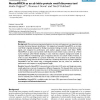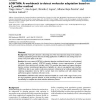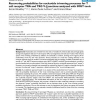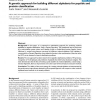BMCBI
2008
13 years 11 months ago
2008
Background: Discovering overrepresented patterns in amino acid sequences is an important step in protein functional element identification. We adapted and extended NestedMICA, an ...
BMCBI
2008
13 years 11 months ago
2008
Background: Testing for selection is becoming one of the most important steps in the analysis of multilocus population genetics data sets. Existing applications are difficult to u...
BMCBI
2008
13 years 11 months ago
2008
Background: Comparative prediction of RNA structures can be used to identify functional noncoding RNAs in genomic screens. It was shown recently by Babak et al. [BMC Bioinformatic...
BMCBI
2008
13 years 11 months ago
2008
Background: Despite the widespread usage of DNA microarrays, questions remain about how best to interpret the wealth of gene-by-gene transcriptional levels that they measure. Rece...
BMCBI
2008
13 years 11 months ago
2008
Background: Nucleotides are trimmed from the ends of variable (V), diversity (D) and joining (J) genes during immunoglobulin (IG) and T cell receptor (TR) rearrangements in B cell...
BMCBI
2008
13 years 11 months ago
2008
Background: Genes interact with each other as basic building blocks of life, forming a complicated network. The relationship between groups of genes with different functions can b...
BMCBI
2008
13 years 11 months ago
2008
Background: In this paper, it is proposed an optimization approach for producing reduced alphabets for peptide classification, using a Genetic Algorithm. The classification task i...
BMCBI
2008
13 years 11 months ago
2008
Background: Information obtained from diverse data sources can be combined in a principled manner using various machine learning methods to increase the reliability and range of k...
BMCBI
2008
13 years 11 months ago
2008
Background: Kernel-based classification and regression methods have been successfully applied to modelling a wide variety of biological data. The Kernel-based Orthogonal Projectio...
BMCBI
2008
13 years 11 months ago
2008
Background: High-density short oligonucleotide microarrays are a primary research tool for assessing global gene expression. Background noise on microarrays comprises a significan...






